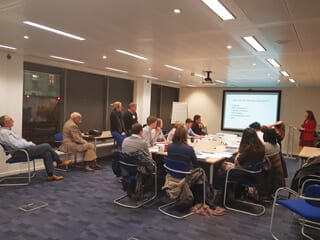
Latest News, YEP
The first presentation of The Young Engineers Program (YEP) also start at CB&I in London with an excellent presentation on the Basics of Corrosion by Jane Lomas. The event was opened by Bill hedges of BP and continues through the year with 9 modules including a Case Study which the delegates will present back at the London Branch meeting in November 2018.
The discussion was all encompassing but dealt with the basics of corrosion from first principals;
- Basic Principles
- Anodic and Cathodic Areas
- What Controls Corrosion rates
- Corrosive Environments
- Common Types of Corrosion
- Pitting
- Crevice attack
- Galvanic corrosion
- Stray current corrosion
- Stress corrosion cracking
- Microbially induced corrosion
The group enjoyed a networking session after the meeting at a local restaurant courtesy of The Institute of Corrosion.
The next YEP meeting will be Welding and NDT Techniques to be presented by Alan Denney on Wednesday 21st February at CB&I in London.
We are extremely grateful to Jane Lomas and Sadegh Parvizi at CB&I and all the other members of ICorr that give up their time freely to assist our Young Engineers with their career development
For complete article of the newsletter please click link below;
YEP News – JAN2018 – Corrosion Fundamentals[5783]
Latest News, London Branch
By:Hamed Habibi – Speir Hunter Limited
This presentation introduced and explain the benefits of Stress Monitoring in Pipeline Integrity Management. The technique is the only inspection technique that can simultaneously map the lateral position and depth of cover of the pipeline whilst also providing comprehensive defect detection. Moreover, it provides additional deliverables that anticipate the increasing demand of pipeline regulatory authorities such as the location of casings and wrinkle bends.
Hamed talked the audience through the benefits of using this method which is developing to be known as silver bullet of pipeline integrity as it is the only method of measuring stress in pipeline wall. He explained the physical principles of the method that is also capable of measuring the depth of cover, lateral position and detecting welded joints. Specifications of this innovative method was detailed in terms of achieved performance in field trials which took loads of interests among audience. Loads of case studies were explained by the speaker to display the advantages of this the technique over traditional inspection methods in special cases. The technique which also is named Stress Concentration Tomography is able to assess condition of buried pipelines remotely without any dependency to a specific type of defect, manufacturing size, construction configuration or operating condition that will save a considerable amount of time, effort and budget while it will also provide an accurate 3-dimensional mapping of pipe and surrounding objects.”
For full article of the newsletter please click link below;
London Branch News – JAN17 – Remote Monitoring and YEP[5777].docx
